Sustaining the Salton Sea is critical for millions of migratory birds and the health of 650,000 regional residents.
Frank Ruiz, Director of Salton Sea Programs with Audubon California, looks out at the Salton Sea
The Salton Sea is one of the most important places for birds in North America, but is at risk of losing its ecological value. As the Sea changes, we face unclear impacts on a vital part of the Pacific Flyway and the growing possibility of a toxic dust bowl that will threaten public health for more than a million Californians.
As part of the Colorado River Delta, the sea filled and dried for thousands of years prior to its current, 35-mile-long incarnation, which came into existence as the result of a massive flood of the Colorado River in 1905. The 330-square-mile Sea has partially replaced wetland habitat lost to agricultural and urban conversion in the Colorado River Delta, California’s coast, and the San Joaquin Valley.
The Sea is a globally significant Important Bird Area (IBA). For the past century, the Sea has served as a major nesting, wintering, and stopover site for millions of birds of approximately 400 species. Until recent years, tiny Eared Grebes wintered by the thousands in rafts far out on its surface. American White Pelicans roosted on mudflats and fished for tilapia in its shallows. Migratory shorebirds stopped to migrate and feed along the Sea’s edge. Today’s avifauna is shifting – the Sea is losing the fish-eating birds such as pelicans and cormorants because fish populations are disappearing. Eared Grebes, who have fed on pile worms, are also declining rapidly, from millions to several thousand. Shorebirds, however, that feast on invertebrates along the shore edges, as well as shallow feeding ducks such as Northern Shoveler and Ruddy Duck, are still wintering at, or passing along the Sea, in massive numbers.
Recently, its water level dropped to the point that colonial seabirds began abandoning nesting sites en masse in 2013, and shallow, marshy habitat areas at the sea’s edge have begun to rapidly vanish, particularly at the south end. In 2017, inputs of Colorado River water were transferred from local agricultural uses to urban uses on the coast. As less water flowed into the Sea, it shrunk considerably, becoming more saline and inhospitable to birds, fish, and insects.
We must take immediate action at the Salton Sea to protect human health and establish viable habitat for millions of migratory birds.
Conservation investments at the Salton Sea must embrace a holistic approach, considering the well-being of all waterbirds, including shorebirds.
Conducting community science during a glorious spring migration for the Intermountain West Shorebird Survey
Our latest study shows how biofilm may be providing the biofuel that migratory shorebirds need
Discover the data and resources about the habitats and changes happening at the Salton Sea from across the network.
Cómo un humedal emergente en la Laguna Salton Sea ofrece nuevas esperanzas para las aves migratorias y las comunidades locales.
Audubon California has begun the planning phase for the restoration and enhancement of the newly emerging Bombay Beach Wetland, located by the town of Bombay Beach at the Salton Sea.
Our new, downloadable pocket field guide features some birds of the Coachella Valley that are culturally significant to the Cahuilla people of the Torres-Martinez Band.
Estamos estrenando nuestra nueva, descargable guía de campo de algunas aves del Valle de Coachella, las cuales son culturalmente importante para los Cahuilla.
More than 400 species of birds come to the Salton Sea in California.
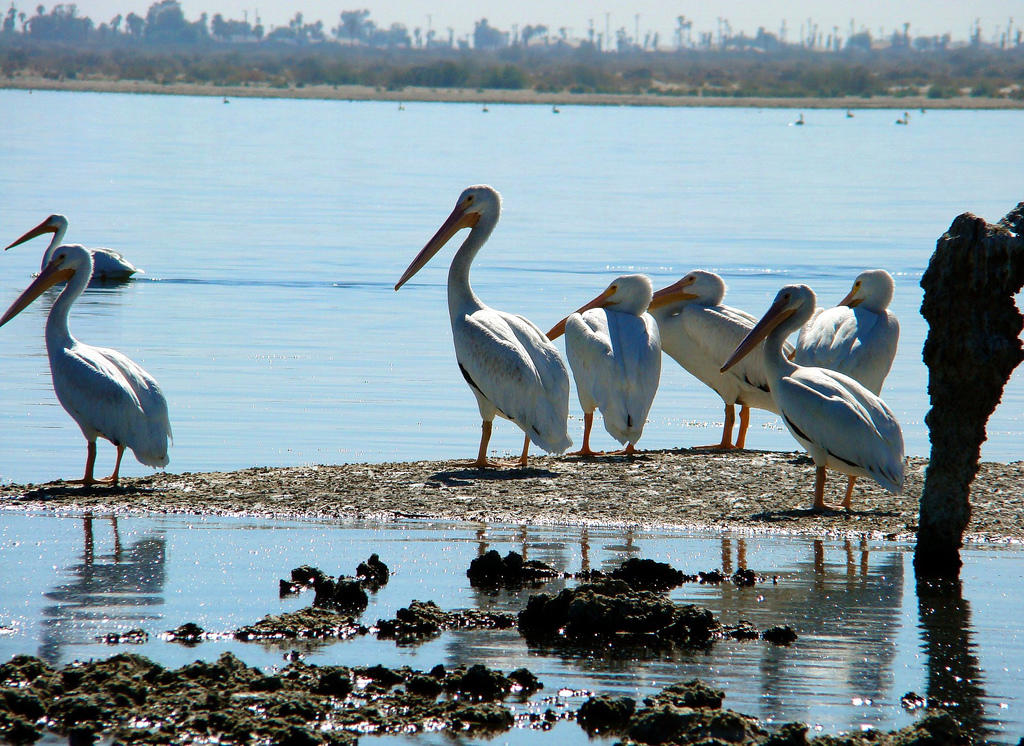
Conservation groups including Audubon California hope that more than $80 million included in the recently-approved state budget will be the first step in a longer, more substantial commitment from the Legislature to addressing the developing environmental crisis at the Salton Sea. The $80.5 million for planning and restoration at the Salton Sea, part of the $167 billion state budget, will ultimately come from Proposition 1 funds approved by voters in 2014.
While the new funding marks the largest amount that the State of California has ever contributed to restoration at the Salton Sea, it is nonetheless only a fraction of the several billion dollars that will be needed to stabilize the situation there.
The funding will help the state pay for the development of a long-term management plan that seeks to address the problems created by reduced water deliveries to California’s largest inland lake. As the Salton Sea shrinks in the coming years, it is expected to have serious ramifications for the more the 400 species of birds that rely on its habitat. Less water will also result in the exposure of hundreds of acres of plays, creating a toxic dust and a serious public health hazard.
Money will also jump-start restoration of habitat along the edge of the lake, creating infrastructure to move water to a number of habitat areas.
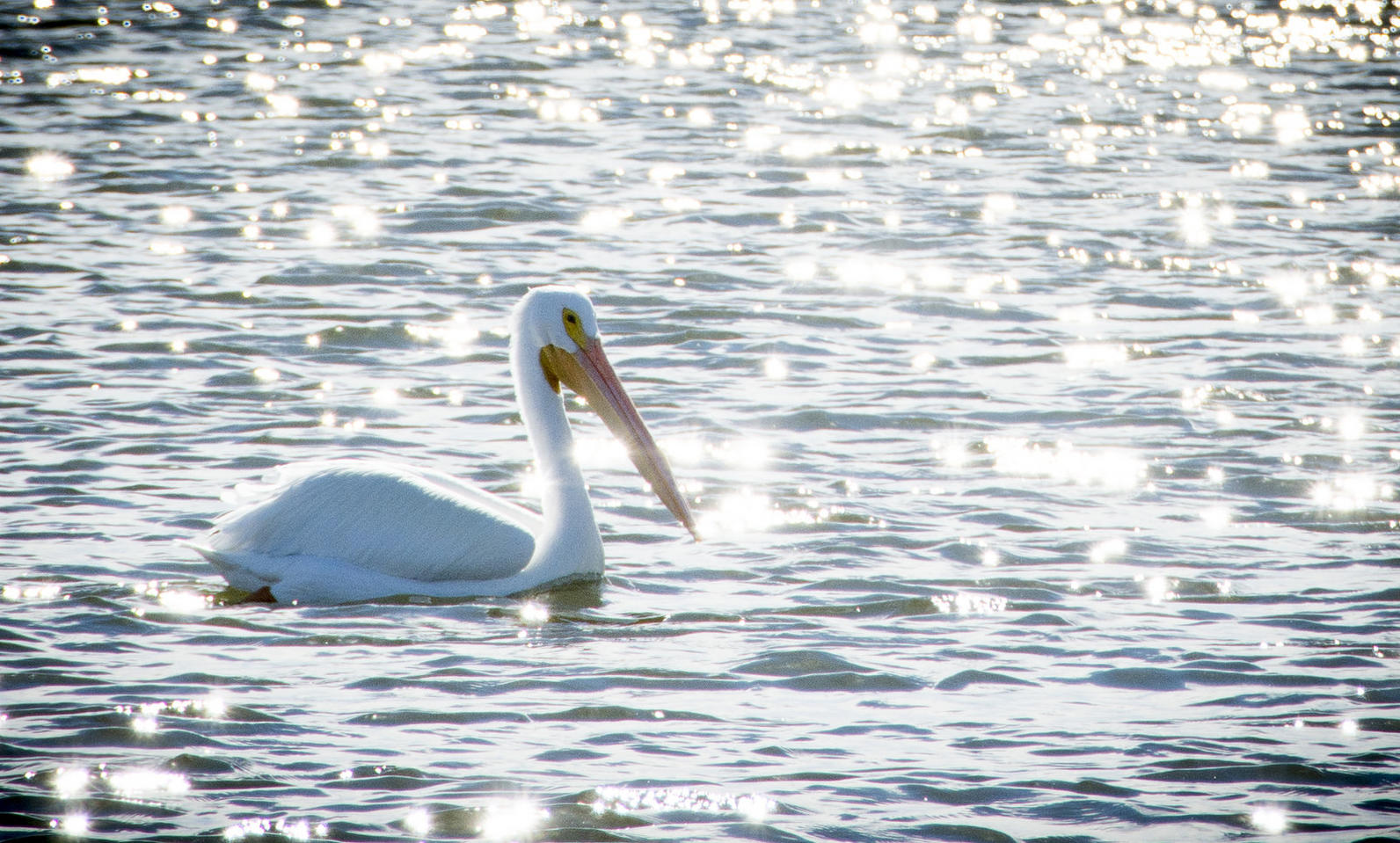
An independent California oversight agency last week called on California Gov. Jerry Brown to declare a state of emergency to resolve the environmental disaster unfolding at the Salton Sea. In a strongly-worded letter, the state’s Little Hoover Commission shared the results of recent hearings, arguing that the Salton Sea should be given as high a priority as high speed rail, the twin tunnels, reduced carbon emissions, and increased renewable energy.
The Commission is responding to the upcoming implementation of water diversions from the Salton Sea that will eventually result in 40 percent less water filling the state’s largest inland lake. This will have a devastating impact on bird habitat and expose huge swaths of lakebed, potentially creating dust that will present a serious public health threat to the 650,000 Imperial County residents nearby.
Audubon California is particularly concerned about the situation at the Salton Sea because of the regions particularly high value to birds. More than 400 species use the Salton Sea, many of which are threatened or endangered species.
“Unlike a wildfire burning out of control or an oil spill blackening beaches, the Salton Sea disaster is slowly unfolding, and has been all but ignored until recently,” the letter reads. “When other disasters destroy California lives and livelihoods, Governors declare a state of emergency. The looming Salton Sea disaster warrants the same level of urgency.”
The commission offered four specific recommendations to get the state’s response to this crisis moving.
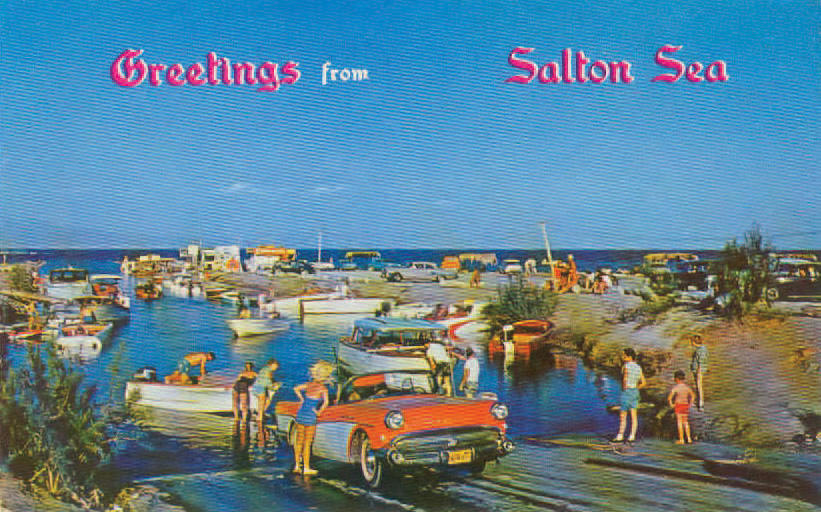
A picture says a thousand words, as the saying goes. The above postcard from the 1950s shows a bustling Salton Sea Marina, a center of fun and recreation.San Bernardino Valley Audubon's Drew Feldman recently visited the exact same location and took the photo below, which shows just how much things have changed over the years.
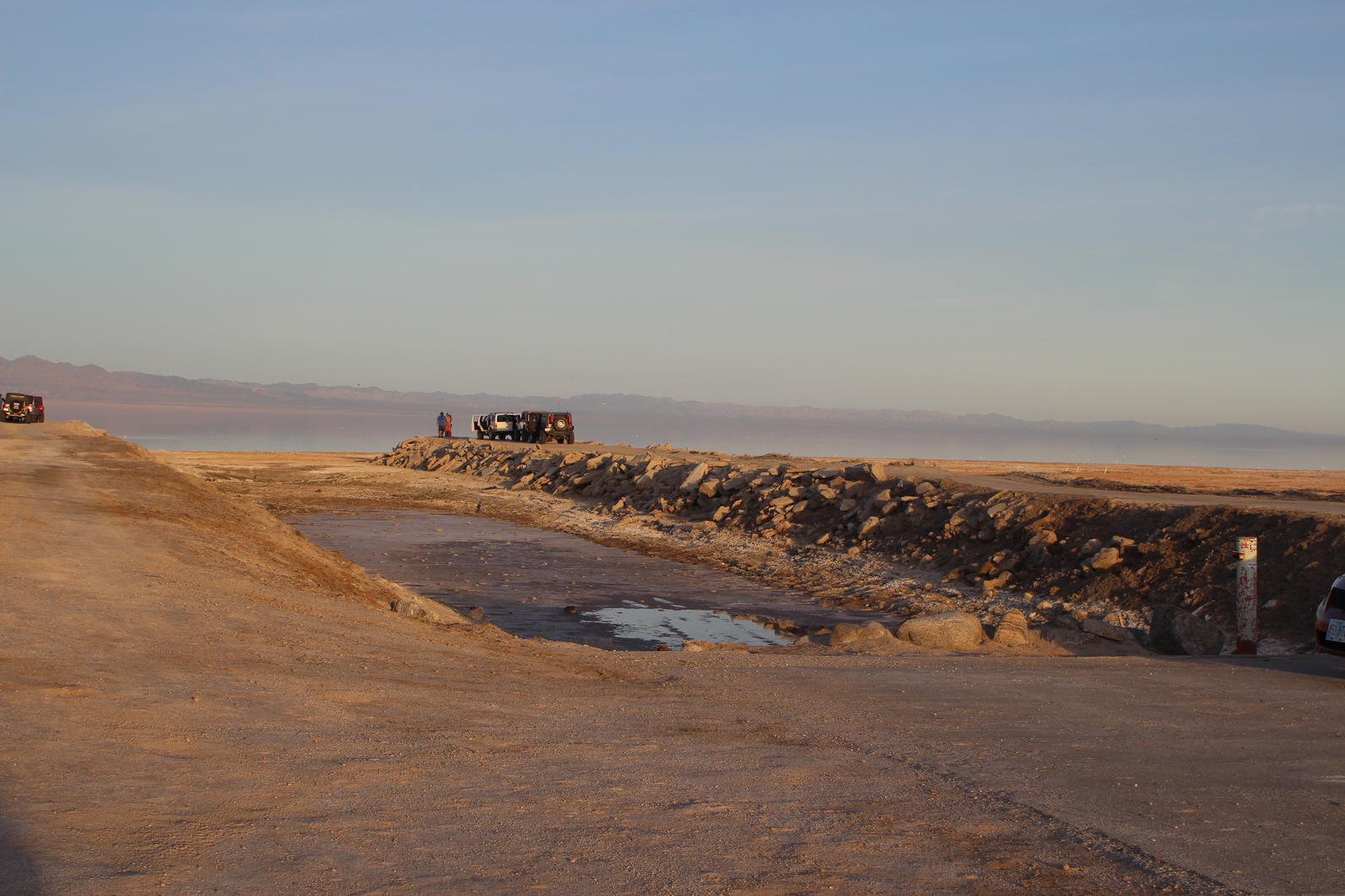
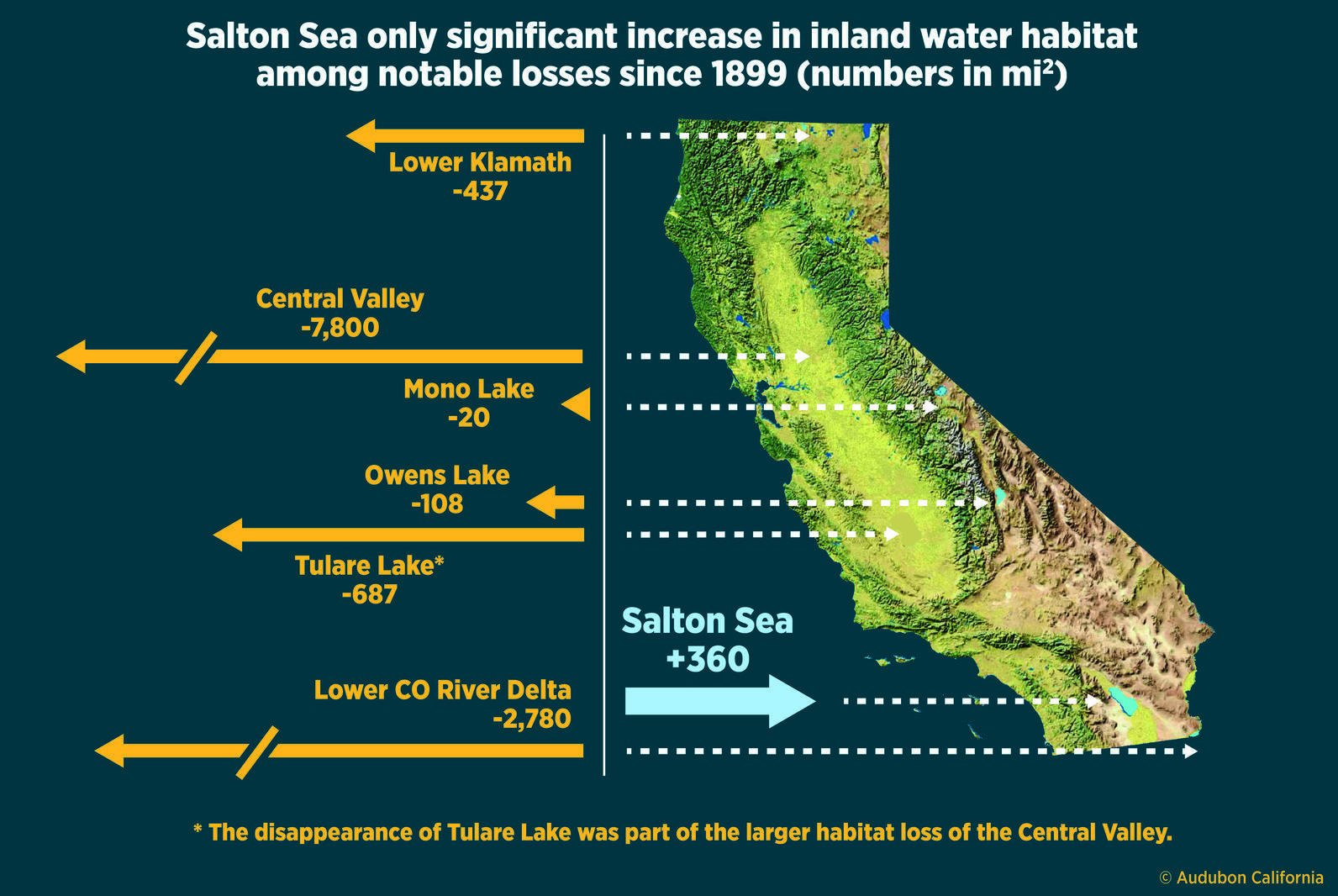
Audubon California Executive Director Brigid McCormack today writes in the Desert Sun that while the narrative around the Salton Sea is often one of environmental decay, the site remains one of the most important places for birds on the Pacific Flyway. She notes that it was created at a time when humans were wiping out natural inland water habitat:
"For birds, the creation of the Salton Sea came at just the right time – just as humans began wiping out wetland habitat throughout California.
Two years before dredging began on the Imperial Valley canal, the last remnants of Tulare Lake disappeared. Once the largest freshwater lake in the West, Tulare Lake was nearly twice the size of the Salton Sea, and anchored more than five million acres of Central Valley wetlands, 95 percent of which are now gone.
In 1906, the federal government began work on the Klamath Project, which eventually eliminated 437 square miles (80 percent) of wetland habitat in the Klamath Basin along the California/Oregon border.
Just a few years later, the Los Angeles Department of Water and Power began diverting water from the 108-square-mile Owens Lake, where Native Americans recalled a sky blackened with migratory birds, and naturalist Joseph Grinnell found great numbers of avocets, phalaropes and ducks. By 1926, Owens Lake was gone.

Fascinating piece today in the Los Angeles Times about the growing concern over declining water levels in Lake Mead that, if they continue to fall, could trigger substantial water cuts in Arizona and New Mexico. Because of this pressure is growing on California users to reduce its use of Colorado River Water. You might recall recently that the Imperial Irrigation District, one of the primary users of water from the Colorado River, has said that will be uncomfortable with any agreement regarding Colorado River water unless the major issues of habitat conservation and dust mitigation at the Salton Sea are resolved.
"All the parties are under pressure to reach an agreement by the end of this year, before the current administration leaves office and the process has to start anew with new federal overseers. But the interstate complexities may pale in comparison with the difficulty of working out agreements among water users within each state. California's Imperial Irrigation District, which has the largest entitlement of Colorado River water, has balked at any agreement to preserve water levels in Lake Mead without a parallel agreement to preserve the Salton Sea. That huge inland pond has suffered as a result of earlier multi-billion-dollar deals by which the Imperial Irrigation District transferred water to San Diego, the MWD and other users.
The shrinkage of the sea already is an environmental and public health disaster. Withholding more water in Lake Mead without a rescue plan would be unacceptable, Imperial Irrigation District General Manager Kevin Kelley said recently. "The Salton Sea has always been the elephant in the room in these talks," he told the Desert Sun newspaper."
When Audubon California talks about the Salton Sea, we often highlight that about 400 species of birds make regular use of this habitat -- massive numbers of sandpipers migrating between Alaska and South America, as much as 90 percent of the world’s Eared Grebes, and large numbers of American White Pelicans, Double-crested Cormorants, the threatened Snowy Plover. Without the Salton Sea, these species and many others would struggle for survival.
The two maps below offer another view of how birds from all over the Western Hemisphere use the Salton Sea. Since 1908, volunteers and researchers have been banding birds for the U.S. Geological Survey's North American Bird Banding Program, and so we have data on where we found birds that were banded at the Salton Sea, as well as where birds were banded that ultimately turned up at the Salton Sea.
Birds banded at the Salton Sea and found elsewhere
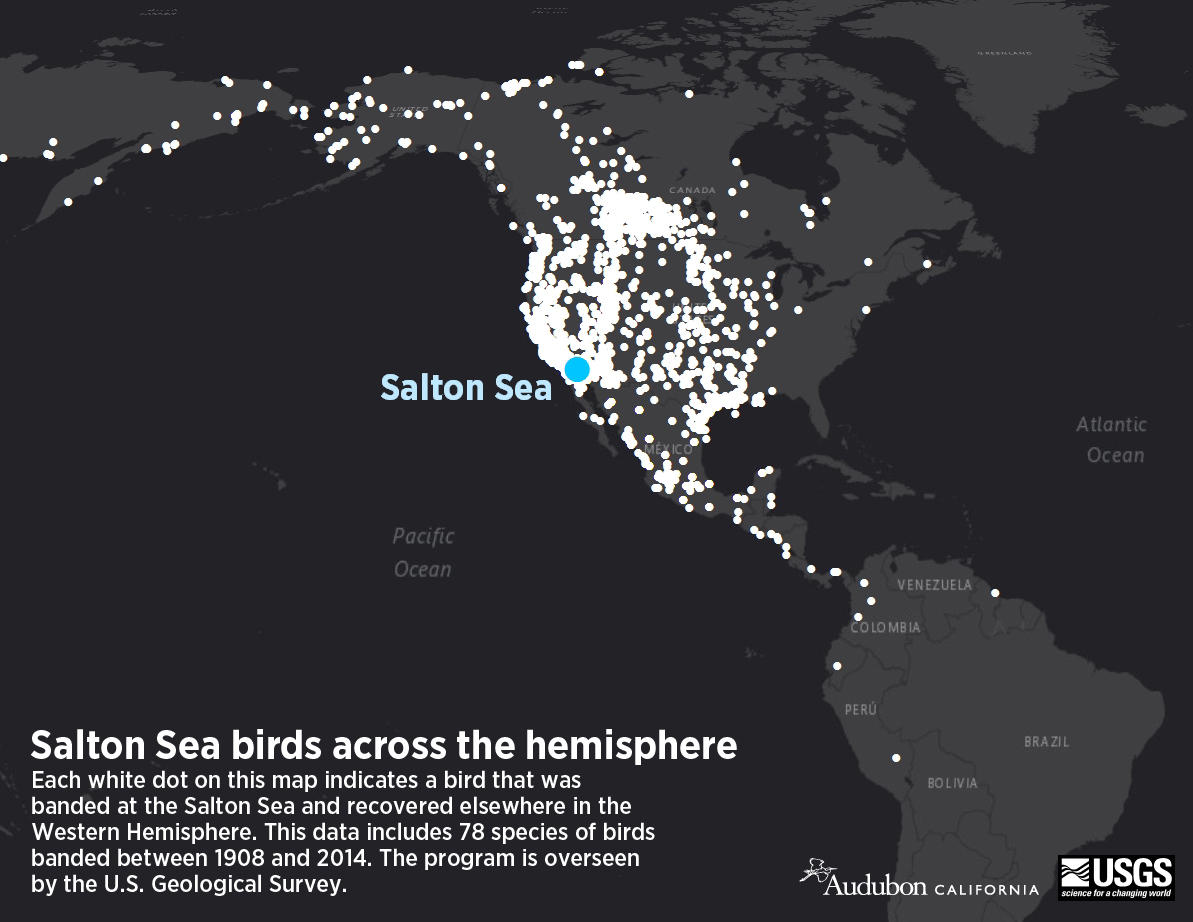
Birds banded throughout the Western Hemisphere and found at the Salton Sea
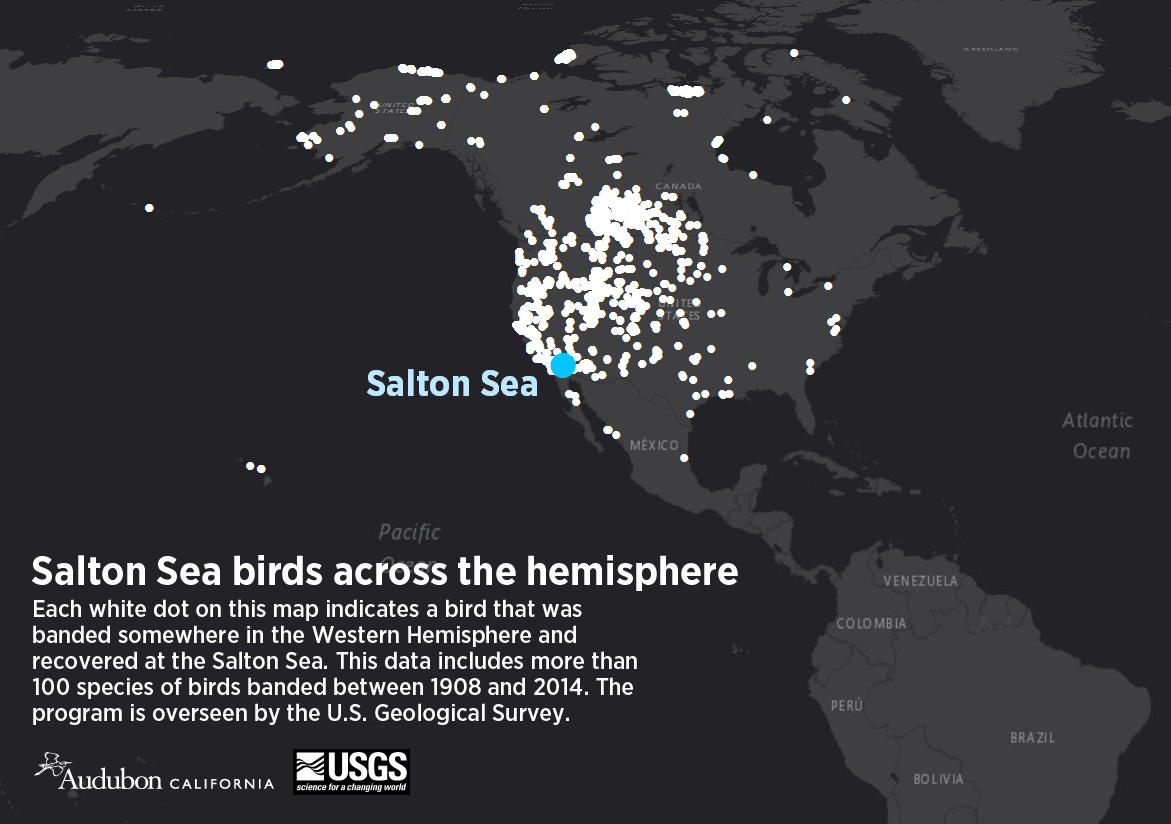
With news that representatives of California, Arizona, and Nevada are negotiating potential cutbacks to relieve water usage from the overtaxed Colorado River, the water district holding the largest rights to Colorado River water said that issues at the Salton Sea need to be resolved before any settlement regarding the Colorado River.
Our newsletter is fun way to get our latest stories and important conservation updates from across the state.
Help secure the future for birds at risk from climate change, habitat loss and other threats. Your support will power our science, education, advocacy and on-the-ground conservation efforts.
Join the thousands of Californians that support the proposed Chuckwalla National Monument.